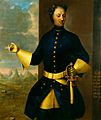House of Wittelsbach facts for kids
The Wittelsbach family was a very important royal family from Bavaria, a region in Germany. They were one of the oldest and most powerful families in Europe.
Members of this family ruled Bavaria for a very long time. They were leaders like Dukes, Electors, or Kings. This rule lasted from 1180 until 1918. Their time as rulers ended after Germany lost World War I.
The Wittelsbachs also ruled many other lands and held important titles across Europe.
Where the Wittelsbachs Ruled
The Wittelsbach family controlled many different areas over the centuries. They were not just rulers of Bavaria. They also governed other important territories.
For example, they were the Counts Palatine of the Rhine. This was a powerful position in the Holy Roman Empire. They held this title from 1214 to 1803, and again from 1816 to 1918.
They also ruled as Margraves of Brandenburg from 1323 to 1373. This was another important German territory.
In the Low Countries, they were the Counts of Holland, Hainaut, and Zeeland. They held these titles from 1345 to 1432.
Later, some Wittelsbachs became Elector-Archbishops of Cologne. This meant they were both religious and political leaders. This happened from 1583 to 1761.
They also ruled parts of western Germany as Dukes of Jülich and Dukes of Berg. These lands were under their control from 1614 until the French occupied them in the late 1700s.
Wittelsbachs as Kings and Emperors
Beyond their main lands, Wittelsbach family members also became kings and emperors in other countries.
Two Wittelsbachs became Holy Roman Emperor. Louis IV was Emperor from 1328 to 1347. Much later, Charles VII was Emperor from 1742 to 1745.
They also ruled as King of the Romans. This was a title for the chosen successor to the Holy Roman Emperor. Rupert held this title from 1400 to 1410.
In Sweden, Wittelsbachs ruled as kings twice. Christopher of Bavaria was King from 1441 to 1448. Much later, a different branch of the family ruled from 1654 to 1720. This included famous kings like Charles X Gustav and Charles XII. They also ruled as Dukes of Bremen-Verden during this time.
The Wittelsbachs even had a king in Greece. Otto I of Greece became the first King of Greece in 1832. He ruled until 1862.
They also briefly held titles like Anti-Kings of Bohemia and King of Hungary. Christopher of Bavaria was also King of Denmark and Norway from 1440 to 1448.
The Wittelsbach family's long history shows how important they were in shaping the history of Germany and Europe. They built many famous castles and palaces, which you can still see today.
Images for kids
-
Coat of arms (13th to 14th century). The white-and-blue lozenges came to the family when Otto II Wittelsbach, Duke of Bavaria acquired the county of Bogen in 1240
-
The Wittelsbach dominions within the Holy Roman Empire (Bavaria, The Netherlands and Palatinate) 1373 are shown as Wittelsbach, among the houses of Luxembourg which acquired Brandenburg that year and Habsburg which had acquired Tyrol in 1369
-
The Electorate of Bavaria highlighted on a map of the Holy Roman Empire in 1648
-
Heidelberg Castle of the Electors of Palatinate
-
The Electorate of Bavaria (1778) and the Kingdom of Bavaria (1816)
-
The Swedish Empire following the Treaty of Roskilde of 1658
-
Louis IV, Holy Roman Emperor (1314–1347)
-
Isabeau of Bavaria, Queen of France (1370–1435)
-
Frederick V, Elector Palatine, King of Bohemia (1596–1632)
-
Charles XII, King of Sweden (1682–1718)
-
Charles VII, Holy Roman Emperor (1742–1745)
-
Otto, King of Greece (1815–1867)
-
Ludwig II, King of Bavaria (1845–1886)
-
The Old Royal Palace in Athens, built for King Otto I by Friedrich von Gärtner, 1841
-
Straubing Castle
-
Heidelberg Castle 1670
-
Bensberg Castle
See also
 In Spanish: Casa de Wittelsbach para niños
In Spanish: Casa de Wittelsbach para niños












































